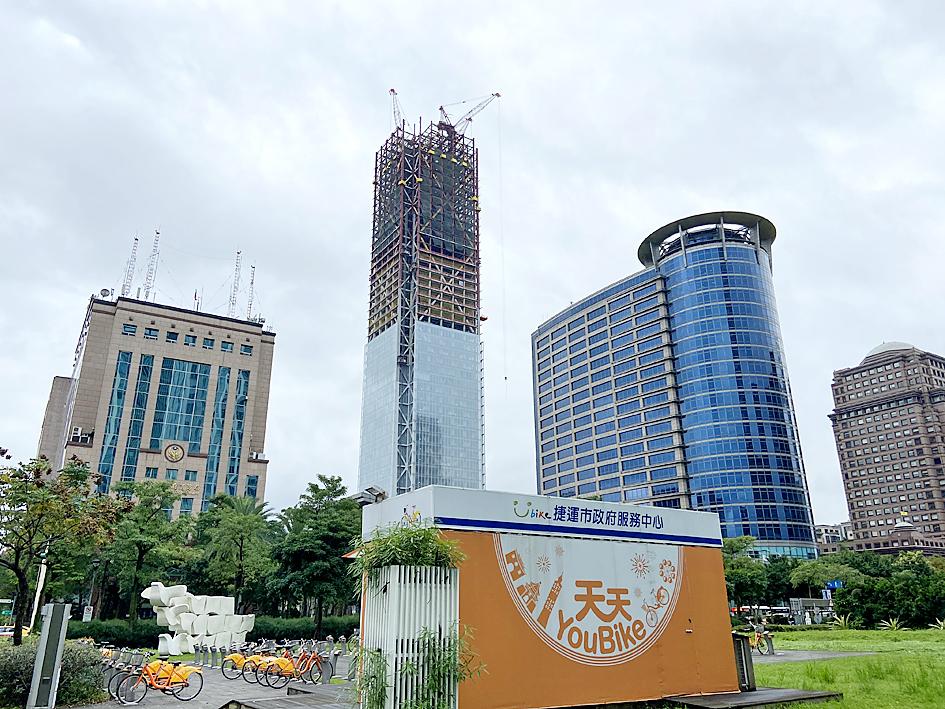Taiwan started off this year with the fastest increase in commercial property sales, which soared 60 percent from a year earlier to US$1.3 billion last quarter, a report by Real Capital Analytics (RCA) found on Monday.
Taiwan is one of a handful of markets worldwide that have kept a lid on the COVID-19 pandemic and avoided a second wave, allowing its commercial real-estate market to power on, driven almost entirely by local companies expanding capacity alongside a strong economy, it said, adding that all signs point to yet another vibrant year for property investment.
Taiwan’s GDP growth last quarter hit 8.16 percent and might continue to expand on the back of strong demand for electronics and non-tech products, official data showed.

Photo: Hsu Yi-ping, Taipei Times
However, investment activity across major income-producing property types in the Asia-Pacific region slipped 12 percent year-on-year to US$29.6 billion, with only five of major commercial markets seeing higher deal volumes, it said.
China overtook Japan as the most active commercial property market by trading value, which reached US$8 billion, representing a 4 percent increase from the same period last year, it said.
Momentum in Taiwan and Hong Kong is building up in light of large double-digit percentage gains, it said, adding that activity in Singapore jumped by 200 percent due to a low base last year, it said.
Japan was a drag on overall investment in the region, with trading value shrinking to US$6.9 billion, it said.
While Japan fared the weakest, its result masks the resilient performance of Tokyo, which saw a robust cross-border investment appetite, it said.
Dealmaking in South Korea also trended down, even though the market posted record levels of activity last year, it said.
The hotel sector remained the weakest, with trading volume plunging more than 50 percent over the past 12 months as the number of deals dried up, it said.
About US$1.5 billion in hotel deals have fallen through since the beginning of last year, RCA data showed.
In particular, deals in the South Pacific and Southeast Asia have almost all evaporated.
The comeback in retail investment activity continued, with sales rising to US$5.7 billion, or a 2 percent increase from a year earlier, it said.
The retail recovery corresponded with price falls across major markets, driven by retailers rationalizing their occupancy strategies throughout the past 12 months.
Furthermore, some Asia-Pacific markets have been able to return to normalcy, allowing trading operations to revive and draw attention from investors, it said.

UNCERTAINTY: Innolux activated a stringent supply chain management mechanism, as it did during the COVID-19 pandemic, to ensure optimal inventory levels for customers Flat-panel display makers AUO Corp (友達) and Innolux Corp (群創) yesterday said that about 12 to 20 percent of their display business is at risk of potential US tariffs and that they would relocate production or shipment destinations to mitigate the levies’ effects. US tariffs would have a direct impact of US$200 million on AUO’s revenue, company chairman Paul Peng (彭雙浪) told reporters on the sidelines of the Touch Taiwan trade show in Taipei yesterday. That would make up about 12 percent of the company’s overall revenue. To cope with the tariff uncertainty, AUO plans to allocate its production to manufacturing facilities in

TAKING STOCK: A Taiwanese cookware firm in Vietnam urged customers to assess inventory or place orders early so shipments can reach the US while tariffs are paused Taiwanese businesses in Vietnam are exploring alternatives after the White House imposed a 46 percent import duty on Vietnamese goods, following US President Donald Trump’s announcement of “reciprocal” tariffs on the US’ trading partners. Lo Shih-liang (羅世良), chairman of Brico Industry Co (裕茂工業), a Taiwanese company that manufactures cast iron cookware and stove components in Vietnam, said that more than 40 percent of his business was tied to the US market, describing the constant US policy shifts as an emotional roller coaster. “I work during the day and stay up all night watching the news. I’ve been following US news until 3am

COLLABORATION: Given Taiwan’s key position in global supply chains, the US firm is discussing strategies with local partners and clients to deal with global uncertainties Advanced Micro Devices Inc (AMD) yesterday said it is meeting with local ecosystem partners, including Taiwan Semiconductor Manufacturing Co (TSMC, 台積電), to discuss strategies, including long-term manufacturing, to navigate uncertainties such as US tariffs, as Taiwan occupies an important position in global supply chains. AMD chief executive officer Lisa Su (蘇姿丰) told reporters that Taiwan is an important part of the chip designer’s ecosystem and she is discussing with partners and customers in Taiwan to forge strong collaborations on different areas during this critical period. AMD has just become the first artificial-intelligence (AI) server chip customer of TSMC to utilize its advanced

Six years ago, LVMH’s billionaire CEO Bernard Arnault and US President Donald Trump cut the blue ribbon on a factory in rural Texas that would make designer handbags for Louis Vuitton, one of the world’s best-known luxury brands. However, since the high-profile opening, the factory has faced a host of problems limiting production, 11 former Louis Vuitton employees said. The site has consistently ranked among the worst-performing for Louis Vuitton globally, “significantly” underperforming other facilities, said three former Louis Vuitton workers and a senior industry source, who cited internal rankings shared with staff. The plant’s problems — which have not